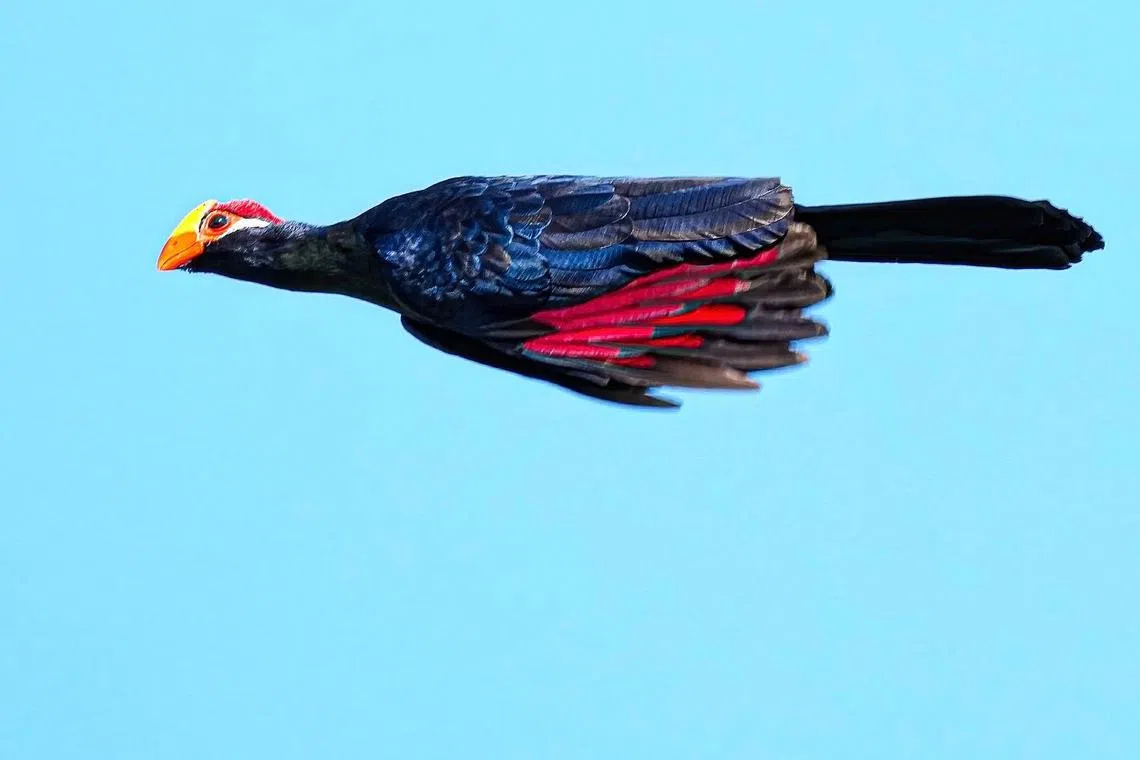Rare sightings of non-native violet turaco in Seletar enthrals bird enthusiasts online
Sign up now: Get ST's newsletters delivered to your inbox

The violet turaco is native to West Africa, but one was spotted outside Singapore's Seletar Camp on Jan 3.
PHOTO: ANDY CHEW
Follow topic:
SINGAPORE – On the morning of Jan 3, Mr Andy Chew set off for the Hampstead Wetlands Park in Seletar, in search of the violet turaco.
Though the bird is native to the tropical forests of West Africa, recent sightings of one such bird had been reported in a chat group, prompting his trip there, said Mr Chew.
This was the 51-year-old nature photographer’s third attempt to spot the bird.
Its deep violet plumage and colourful facial pattern – a yellow and orange-coloured beak and a white streak behind its eyes – have long captivated birdwatchers.
“When I arrived at the location, I was all alone. I was not optimistic at all in finding this bird as the area it flies around is big,” said Mr Chew in a Jan 3 post on the Singapore Wildlife Sightings Facebook group.
He decided to try his luck outside the nearby Seletar Camp, with other bird watchers reporting previous sightings in the area. Once there, he heard the bird’s distinctive call and tried to locate it.
A cleaner from the camp then saw Mr Chew and pointed him in the direction of the bird’s favourite tree – located at a carpark outside the camp.

The bird has become the centre of attention in several social media groups on wildlife sightings, with posts such as Mr Chew’s bringing in comments by enthralled avian enthusiasts.
PHOTO: ANDY CHEW
“I quickly headed over and after 20 minutes of waiting, it came out to chase a crow away. That was the beginning of our 30-minute one-to-one session,” said Mr Chew in his Facebook post.
He told The Straits Times that it was tiring spotting the bird, as it does not stay in one location for too long.
“Knowing a few of its favourite spots did help me to locate the bird faster,” said Mr Chew, who previously photographed another violet turaco at the Bird Paradise in Mandai.
“Fortunately this morning, the first stop was the one where I heard its call and subsequently the sighting was at one of the trees in front of Seletar Camp where it had perched before.”
The bird has become the centre of attention in several social media groups on wildlife sightings, with posts such as Mr Chew’s bringing in comments by enthralled avian enthusiasts.
“Incredible experience... and a reward at the end,” commented Facebook user Marianne Pereira, on Mr Chew’s post.
Mr Chew said: “This is an African bird, hence when it was first spotted, it got everyone excited. It also got everyone guessing and talking about how it actually landed in Singapore.
“Many concluded it is an escapee from a private aviary.”
One such person is Bird Society of Singapore vice-president Movin Nyanasengeran, who said that the bird is likely an escapee from the pet trade.
“Turacos are not uncommonly traded. I’ve seen the white-crested turaco and purple-crested turaco in pet shops in Singapore,” he said.
“So the violet turaco being in the pet trade would be totally unsurprising.”
The bird is also non-native to Singapore and does not migrate, added Mr Nyanasengeran.
When asked what the public should do if they spot the bird, he said they should observe the bird from a distance and not attempt to catch it.
This is because they may not know how to handle the bird and may accidentally injure it, or trap other birds unintentionally, he added.
“The fact that it’s alone also means it’s unlikely to have any significant impact on native species.”
Angelica Ang is a journalist on The Straits Times’ breaking news team, where she covers the latest local and international developments.


